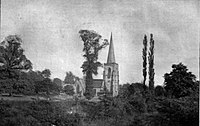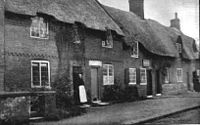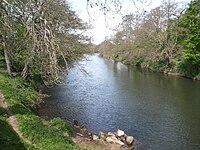Duffield, Derbyshire
[3] Although it has been suggested that, once farming began, they would have inhabited the plains of the Derwent and Ecclesbourne, they would most likely have retreated to higher ground during the winter floods.
It has been suggested that they built a fort to protect the ford across which the caravans of lead from Wirksworth joined Rykneld Street at Derby, en route for the North Sea ports, though this is disputed.
Most of this became the ancient parish of Duffield, which contained the townships of Hazlewood, Holbrook, Makeney, Milford, Shottle, and Windley, and the chapelries of Belper, Heage, and Turnditch.
Its position, so far from the village, it is thought, arose from its purpose, in Anglo-Saxon times, of serving travellers crossing the river on their way from Ashbourne to Nottingham.
Following the rebellion by Robert de Ferrers, 6th Earl of Derby his lands became part of the Duchy of Lancaster until the reign of Charles I.
In the forest, there had been plentiful game, and a supply of timber, particularly oak, while the farmland was exceedingly fertile, though prone to flooding.
[7] Sir Roger Mynor was High Sheriff in 1514, Sergeant of the King's Cellar, an official of Duffield Frith under the Duchy of Lancaster and a Commissioner of Peace for the County of Derby.
It is thought that these were what attracted the de Ferrars family to the area, and there are frequent references to iron-working in historical records, with a forge near to the present Baptist Chapel.
By the nineteenth century, the major occupation in the village itself was framework knitting, encouraged by Jedediah Strutt's famous 'Derby Rib', while a paper mill opened at Peckwash.
A permanent station was opened in 1841 in its present position, as the village expanded with homes for the Midland Railway workers and management, the former settling in the village around the end of King Street, the managers in larger houses further along the main road and further up King Street and Hazlewood Road.
When the new station was extended with the Wirksworth branch, it created a good deal more upheaval, since the line cut across the road north out of the village.
Clearly, they were a speculative middle-class project, but in 1910 they were isolated among fields half a mile from the village – hardly attractive, one would have thought, to prospective purchasers.
When the Commissioners appointed by Parliament to divide up the common and waste lands of Duffield Parish sat in 1787, they held their meetings at the King's Head.
In the days before Hazelwood had its own cemetery, it is said that funeral parties would stop for refreshment before completing their journey to the church, and would leave the coffin resting on that wall.
The attraction of the village for housebuyers centres on the successful secondary school, Ecclesbourne and good transport links.




